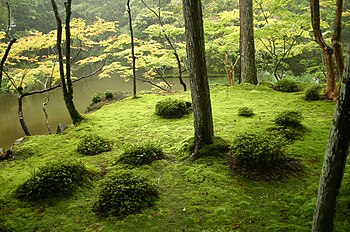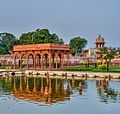Portal:Gardening
The Gardening Portal

Gardening is the process of growing plants for their vegetables, fruits, flowers, herbs, and appearances within a designated space. Gardens fulfill a wide assortment of purposes, notably the production of aesthetically pleasing areas, medicines, cosmetics, dyes, foods, poisons, wildlife habitats, and saleable goods (see market gardening). People often partake in gardening for its therapeutic, health, educational, cultural, philosophical, environmental, and religious benefits. Gardening varies in scale from the 800 hectare Versailles gardens down to container gardens grown inside. Gardens take many forms, some only contain one type of plant while others involve a complex assortment of plants with no particular order. (Full article...)
Horticulture is the art and science of growing plants. This definition is seen in its etymology, which is derived from the Latin words hortus, which means "garden" and cultura which means "to cultivate". There are various divisions of horticulture because plants are grown for a variety of purposes. These divisions include, but are not limited to: gardening, plant production/propagation, arboriculture, landscaping, floriculture and turf maintenance. For each of these, there are various professions, aspects, tools used and associated challenges; Each requiring highly specialized skills and knowledge of the horticulturist. (Full article...)
General images -
Selected article -

Japanese gardens (日本庭園, nihon teien) are traditional gardens whose designs are accompanied by Japanese aesthetics and philosophical ideas, avoid artificial ornamentation, and highlight the natural landscape. Plants and worn, aged materials are generally used by Japanese garden designers to suggest a natural landscape, and to express the fragility of existence as well as time's unstoppable advance. Ancient Japanese art inspired past garden designers. Water is an important feature of many gardens, as are rocks and often gravel. Despite there being many attractive Japanese flowering plants, herbaceous flowers generally play much less of a role in Japanese gardens than in the West, though seasonally flowering shrubs and trees are important, all the more dramatic because of the contrast with the usual predominant green. Evergreen plants are "the bones of the garden" in Japan. Though a natural-seeming appearance is the aim, Japanese gardeners often shape their plants, including trees, with great rigour. Japanese literature on gardening goes back almost a thousand years, and several different styles of garden have developed, some with religious or philosophical implications. A characteristic of Japanese gardens is that they are designed to be seen from specific points. Some of the most significant different traditional styles of Japanese garden are the chisen-shoyū-teien ("lake-spring-boat excursion garden"), which was imported from China during the Heian period (794–1185). These were designed to be seen from small boats on the central lake. No original examples of these survive, but they were replaced by the "paradise garden" associated with Pure Land Buddhism, with a Buddha shrine on an island in the lake. Later large gardens are often in the kaiyū-shiki-teien, or promenade garden style, designed to be seen from a path circulating around the garden, with fixed stopping points for viewing. Specialized styles, often small sections in a larger garden, include the moss garden, the dry garden with gravel and rocks, associated with Zen Buddhism, the roji or teahouse garden, designed to be seen only from a short pathway, and the tsubo-niwa, a very small urban garden. (Full article...)
Selected image

Related portals
Did you know -
- ... that the New Zealand Geographic Board initially rejected the name of the Garden of Eden Ice Plateau for being biblical in origin?
- ... that a "bat ensnared by a plant" was discovered in the garden of the Palestine Museum of Natural History?
- ... that actress Katharine Hepburn threatened to remove her name from a garden in Dag Hammarskjöld Plaza when New York City officials said they would not widen the plaza?
- ... that much of what we know of medieval gardens comes from illuminated manuscripts?
- ... that The Lord of the Ice Garden, a Polish novel series mixing elements of fantasy and science fiction, has been compared to The Witcher?
- ... that Bulandshahr's ornate Garden Gate was built on the site of a "filthy" drainage ravine?
- ... that popular garden plants like malfurada often escape from cultivation and become invasive?
- ... that Nusrati attributes the virtues of a good ruler to his patron Ali Adil Shah II in The Rose Garden of Love?
Things you can do
- This list is transcluded from the tasks list page. To edit the list, click here
 |
Here are some tasks awaiting attention:
|
WikiProjects
Topics
Categories
Associated Wikimedia
The following Wikimedia Foundation sister projects provide more on this subject:
-
Commons
Free media repository -
Wikibooks
Free textbooks and manuals -
Wikidata
Free knowledge base -
Wikinews
Free-content news -
Wikiquote
Collection of quotations -
Wikisource
Free-content library -
Wikiversity
Free learning tools -
Wiktionary
Dictionary and thesaurus

































































































